Ways to combat diseases and pests of dracaena
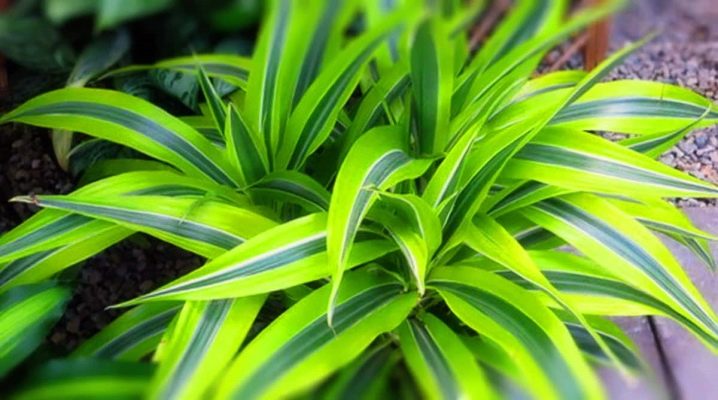
Dracaena is a beautiful evergreen plant that adorns many apartments and offices. This tree, which resembles a palm tree, is valued by flower growers not only for its attractive appearance, but also for its picky care. However, even such an unpretentious plant is often attacked by pests and diseases. Read this article to learn how to prevent the problem, and what to do if preventive measures have not worked.
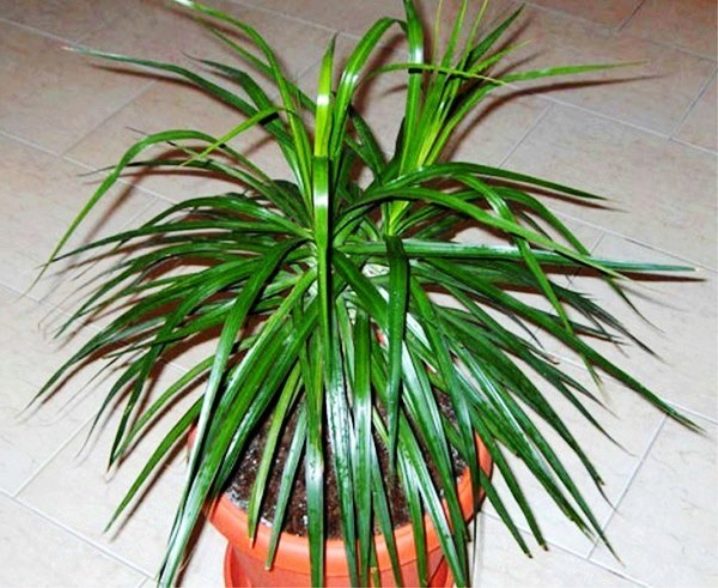
The main signs
The fight against the disease should be started as soon as the disease is detected. There are several signs that indicate the onset of the disease. The disease can be recognized by white, yellow, brown, brown, rusty spots on the leaves, sometimes the ends of the leaf plates dry or discolor. If the dracaena stretched out, dropped the leaves, its top dried up, then this also indicates a problem. A brown coating on the trunk and leaves also indicates the onset of a disease, such as root rot caused by overflow.
Twisted leaves, their yellowness, softness of the root also speak of infection, these signs may indicate, for example, the fungus pytium. Symptoms of a disease or insect infestation are a red-yellow tint on the leaves, their gradual blackening and wilting: the edges drop, the trunk becomes soft, the plant itself does not develop well, its growth is significantly slowed down.
If you do not start the methods of dealing with disease or pests in a timely manner, the tree dies.
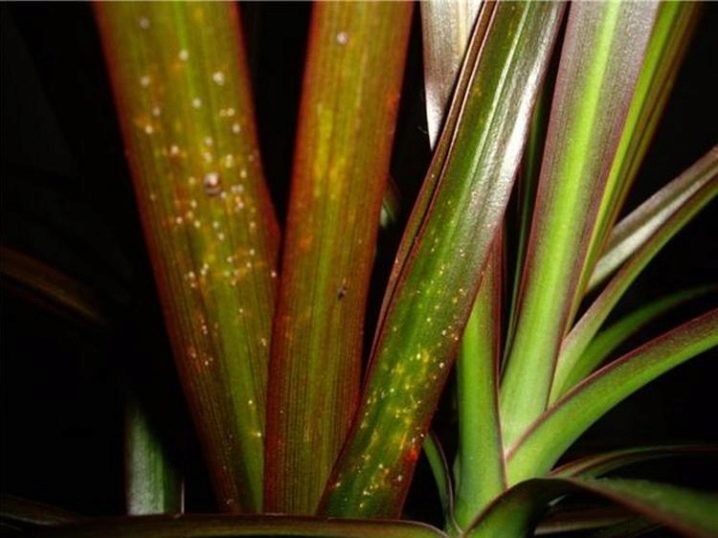
Causes of diseases
Most often, the diseases of this exotic tree and the attack of pests can provoke errors in plant cultivation.
- Low humidity... The homeland of culture is the tropics, therefore, it is quite capricious in relation to the moisture content of the external environment. Apartment maintenance is usually limited to a maximum of 50% humidity, so the flower needs regular spraying, frequent watering, in addition, you can use household humidifiers.
- Excessive lighting... Under the influence of direct ultraviolet rays, the formation of burns on the leaf plates is possible, gradually the leaves dry out. Most often variegated varieties are subject to this influence of the sun. To avoid such consequences, it is required to create a shade for the plant.
- Excessive feeding... Overfeeding can threaten to reduce immunity to most diseases.
- Freezing. Leaves can wilt even at temperatures below +14 degrees, since in its natural environment this culture develops at +25 degrees. A flower can freeze if it is placed on a windowsill, and windows are often opened in winter, a draft forms, and sharp temperature fluctuations occur. Under the influence of such a sudden change in the microclimate, the plant becomes not only vulnerable to many ailments and pests, but may even die. The bark shrivels, the trunk softens, the leaves fly around - all these are signs of freezing.
- Overflowing. Due to the high moisture content of the soil, the roots begin to rot, the trunk acquires a very soft structure, dark spots form on the leaves, worms, midges, and mold start up in the ground.
- Elevated temperature... Too much heat in the room becomes a favorable breeding ground for insect pests.
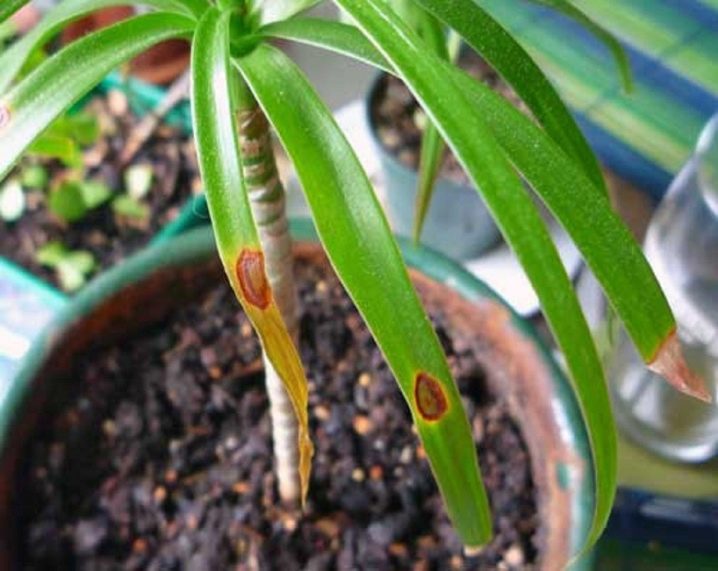
Diseases
This plant is affected by several types of diseases, and each of them is characterized by different characteristics.
- Alternaria The disease is characterized by the formation of medium pale brown spots with a whitish center on the leaves. Little by little, the destroyed areas darken and die off.
- Heterosporia. Signs: beige spots with a red frame appeared on the leaves. As the disease progresses, these marks acquire a greenish-gray tint.
- Gray rot. This disease can be recognized by light brown spots, which eventually become covered with a whitish bloom with fluff. Another sign of ailment is black dots on the leaf plate. Most often it is formed if a florist has flooded a palm tree.
- Powdery mildew. A light sediment is noticeable on the leaves, gradually darkening and acquiring a brown tint.
- Fusarium. The leaves from the lower tips to the top are covered with yellowness, a watery frame is observed along the edges. As the disease progresses, the upper part of the trunk dries up, the stems become thinner and darker, and dark brown lesions spread throughout the plant.
- Phylostictosis. With this disease, dark brown spots with black blotches are formed on the leaves of an adult plant.
- Bacteriosis The ends of the leaves are covered with a brown tint, brown patches are formed over the entire leaf area. On the stem, trunk and petioles, sores in the oily border can be observed.
- Spotted wilting. On the leaves, yellow-brown stains are formed, which are covered with a bronze color under the influence of ultraviolet radiation. The plant stops growing, the shape of the new leaves is distorted, they are small and unhealthy. Gradually, the specimen dries up and dies.
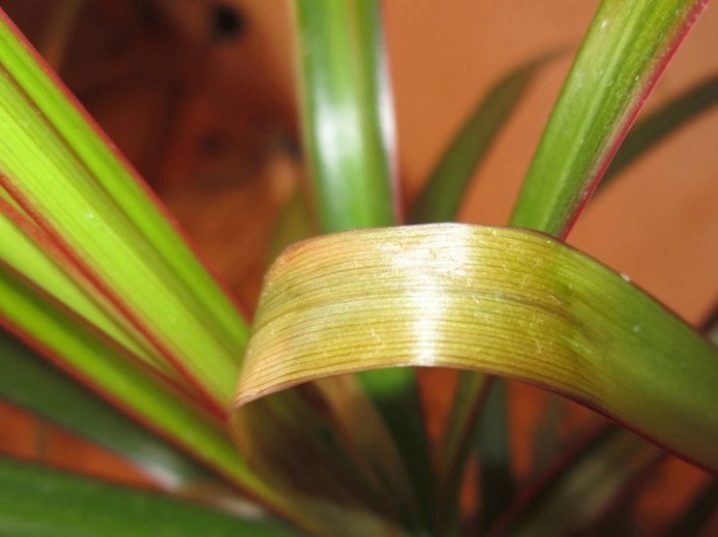
Pests
Check out the list of insect pests, who love to feast on this tropical plant.
- Shield. The specimen is a creature 2-4 mm in size with a gray or yellowish shield. It feeds on the sap of stems and leaves, which after such a "visit" gradually shrink and fall off.
- Thrips. Miniature (up to 2 mm) insects that inhabit the lower part of the leaf plate as a whole order. Light dots form on the outside, the entire side turns gray-brown.
- Aphid. It prefers to feast on the top of the sprouts and the underside of the leaves. Under the influence of an aphid colony, the leaves wither, curl, discolor and fly around.
- Mealybugs. The creatures are white, as if sprinkled with flour sediment. They feed on plant sap, slowing down their development. When the worm attacks, the leaves and rosettes are covered with a cotton-like waxy substance.
- Spider mite. It is a small pale yellow or light green insect that prefers to settle on the inside of the leaf. Under the destructive influence of the pest, white spots with a light cobweb appear on the leaf. The growth of the culture slows down, the immunity to diseases decreases, and besides, the individuals themselves can often be carriers of various diseases.
- Whitefly... This is a small white midge that looks like a moth. Its larvae are found on the inner side of the leaf, they are light green bodies that feed on plant sap and leave secretions in the form of sugar crystals. A palm affected by a whitefly has whitish or yellowish markings and axial lines on the leaves. The insect flies, and therefore is dangerous for all neighboring crops.
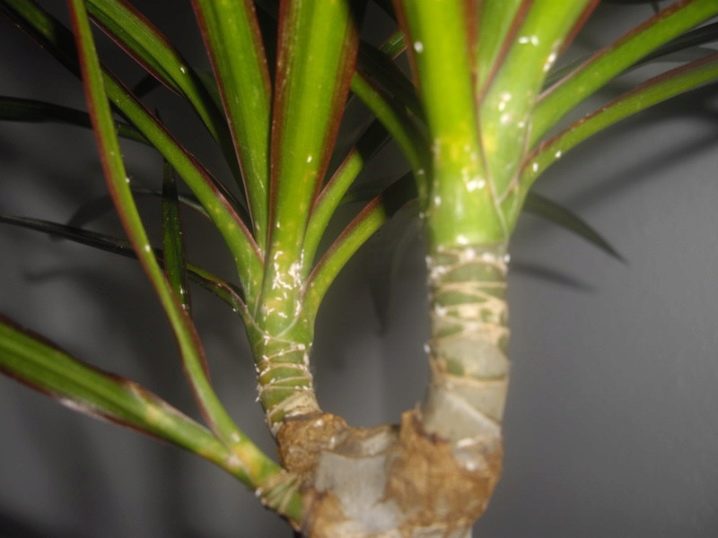
Control methods
To save the plant from death, both specialized means and compositions prepared at home allow. For each type of disease, different methods of struggle are used. There are some ailments that, unfortunately, cannot be treated, but the development process can be stopped, which will allow the tree to revive.
So, for diseases such as alternaria and heterosporiasis, it is allowed to use the same control methods. Leaves and stems are treated with a solution of colloidal sulfur or wood ash, added to the soil mixtures of drugs "Kuprozan", "Oksikhom", "Topaz", the same funds are recommended to be applied to the plant itself.Manipulations are carried out three times every 10 days for a month. It is advisable to moisten the soil during this period not with plain water, but with a solution of potassium permanganate.
To restore a culture affected by gray rot, the means "Kuprozan" and "Topaz" will allow. Before that, all diseased leaves are eliminated and destroyed, the cut sites are processed, healthy parts of the plant are sprayed with the above means.
For a month, it is recommended to add a potassium permanganate solution to the pot (0.25 grams per 1 liter of water).
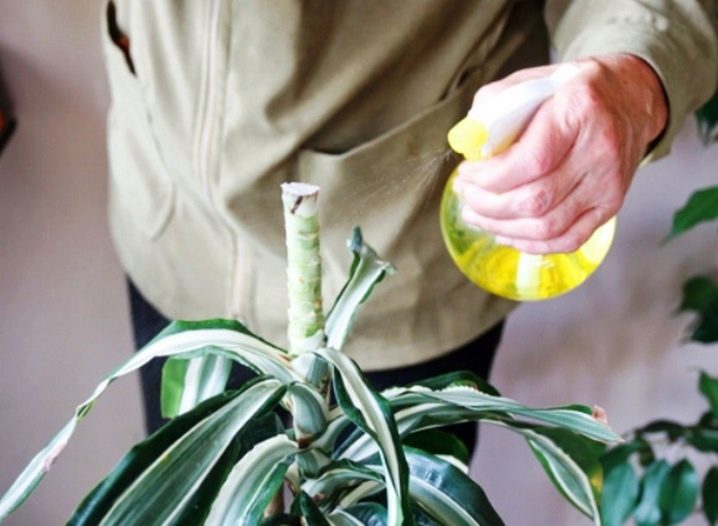
The following procedures will help to revive a flower that has become a victim of powdery mildew:
- white bloom is removed with a napkin dipped in a solution of potassium permanganate;
- colloidal sulfur or crushed activated carbon is poured into the plant;
- the flower is treated with a fungicide twice every 14 days.
Fusarium can be overcome by washing the plant with water. Further, all affected leaves are removed, the cuts are processed, they are added to the soil solution of "Fundazol", "Vectra" or "Benomil". Manipulations are performed 3 times within three weeks, every 7 days. If these methods failed to defeat the disease, then you should go to radical methods and apply strong drugs "Kwardis", "Bravo", "Raek". When it was possible to cope with the disease, it is recommended to add to the watering can for prophylaxis when watering "Fitosporin-M", and when transplanting - "Trichophyte" or "Gumistar".

If phyllostictosis is detected on the plant, then all damaged parts should be cut off and destroyed. It is important to disinfect the sections with crushed activated carbon, iodine or chalk. Over the next three weeks, the palm tree is treated with "Topaz", "Skor" or "Hom" three times. When watering, "Zircon", "Epin", "Humat" dissolve in water.
Bacteriosis and spotted wilting have no cure, but they can be avoided by proper growing conditions. For example, in order to protect the plant from bacteriosis, it is required to avoid too high a temperature in the house and waterlogged soil. Alkalis in the soil can also provoke this disease. Spotted wilting more often affects palms that are deprived of fertilizing in the form of potassium and phosphorus.
To combat insects, both special insecticides and mixtures prepared according to folk recipes can also be used. To rid the plant of the scale insect, it is required to treat the individuals with machine oil, vinegar or alcohol. After a few hours, the pests can be removed. Next, it is necessary to apply soapy foam to the leaves and rinse it thoroughly. The next stage is the processing of the flower with "Aktara", "Permethrin" or "Fufanon". After a week, you can repeat the procedure again for reliability.
To restore a plant affected by a spider mite, treat the leaves with alcohol or vodka, and then wipe them with a damp sponge, sprinkle the flower thoroughly with water, water it and place it in an airtight bag for a couple of days. For a more successful result, put chopped onions and garlic or turpentine in the same film. If the method does not work, then you can eliminate the parasites with acaricides "Neoron", "Agravertin", "Sunmight". They are used up to four times weekly.
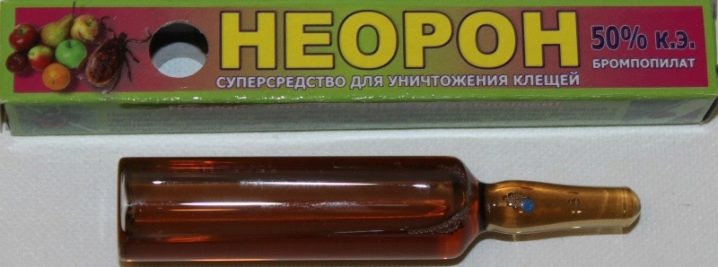
The following methods of struggle will allow you to cope with thrips:
- wipe the leaves with soapy foam or flea shampoo and leave in this form under a film for three days;
- mix 35-40 ml of any vegetable oil with a liter of water and spray the plant with this composition, perform the procedure three times within three weeks;
- treat the palm tree with Fitoverm, Spintor, Actellik every week for 21 days.
The main enemy - the mealybug - is also afraid of alcohol. It is recommended to sprinkle the tree with a soap-alcohol solution, and after a couple of hours rinse the leaves with clean water. All visually distinguishable "lumps" must be removed, the plant and the soil must be treated with an infusion of tobacco crumbs, dry mustard, and red pepper.If these mixtures were not found, you can spot the sheets with any means with wood oil. If folk methods have not helped, use the drugs "Calypso", "Mospilan" (three times a month).
To rid the flower of aphids, the leaves are wiped with soapy foam, the affected areas are cut off, 3-4 times a day, the plant is sprayed with infusions of orange peels, onion peels, needles, any harsh-smelling herbs. From professional formulations it is recommended to use "Biotlin", "Admiral", "Konfidor-Maxi" once a week.

If whitefly midges are on the plant, it is recommended to use Actellik, Fufanon, Inta-Vir. Leaves are processed as long as necessary to destroy all individuals. Using fly tape and spraying dichlorvos in the room will also work.
Prophylaxis
Preventive measures are closely related to the correct care of the crop. It is important to follow the rules of watering, not to overdo it with soil moisture, monitor the temperature and protect the flower from drafts. The flowerpot should be located in a warm place with moderate light. You can choose a suitable site like this: find a place in the room where it would be comfortable for a person to read a book, and put a pot there.
Another rule is to withstand quarantine for newly brought plants to the house for a month. But it is also important to periodically inspect the leaves and trunk for signs of disease, it is better to use a magnifying glass. All suspicious instances should be quarantined. Houseplants and flowers cut from the street should be at a sufficient distance from each other, especially if roses or chrysanthemums are brought into the house.
When choosing a pot for growing a culture, you should carefully sterilize it. All instruments used to cut diseased areas also need constant disinfection. You should regularly clean the leaves from dust and debris.
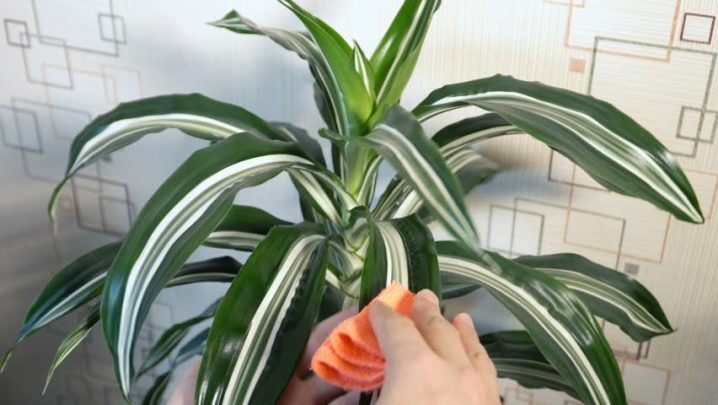
As already noted, the most serious diseases that do not respond to treatment are bacteriosis and spotted wilting. To prevent them, it is important to timely feed the plant with phosphorus-potassium fertilizers, avoid too high a temperature in the room, and water the flower in moderation and on time. Due to the lack of phosphorus in the soil, heterosporiasis can also develop.
For the same reasons, pests appear, so the preventive measures are the same: compliance with all growing rules. In order to prevent the appearance of a spider mite, you can additionally spray the tree with a decoction of cyclamen tubers once a week or irradiate the leaves with a quartz lamp for 2-3 minutes on both sides.
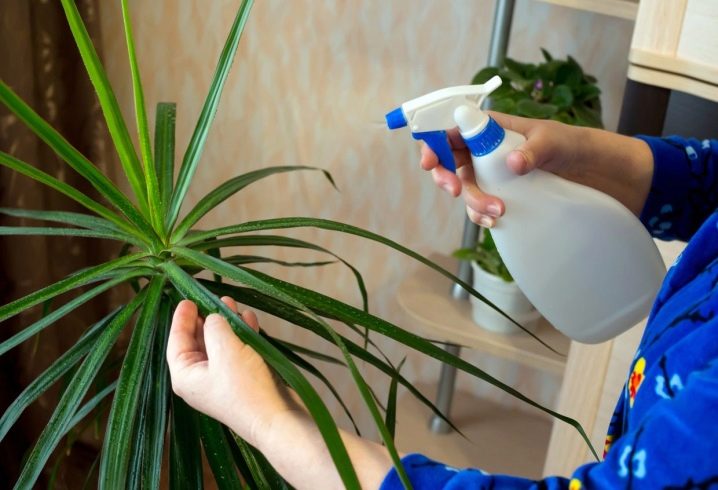































The comment was sent successfully.